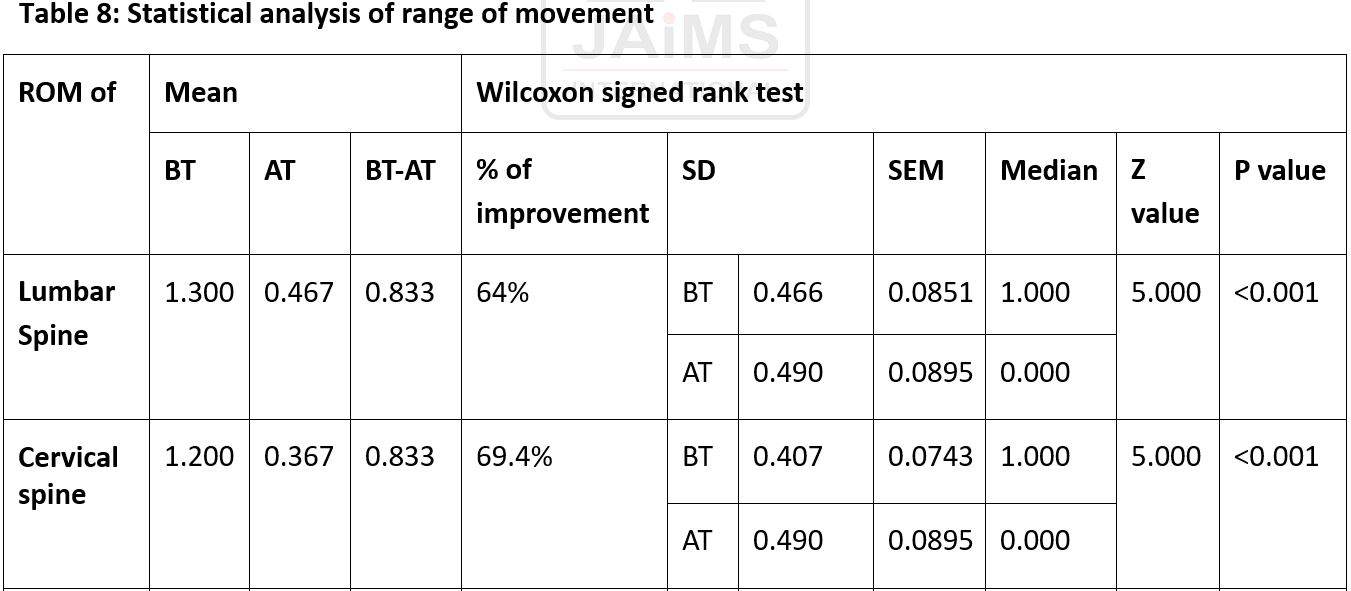A clinical study to evaluate the effect of Nithya Virechana on range of movements of joints in Amavata w.s.r. to Rheumatoid Arthritis
DOI:
https://doi.org/10.21760/jaims.10.4.4Keywords:
Amavata, Rheumatoid Arthritis, Nitya Virechana, Gandharvahastadi Eranda TailaAbstract
Background: Amavata (Rheumatoid Arthritis) is a chronic, progressive inflammatory condition that primarily affects the joints, leading to pain, stiffness, swelling, and restricted mobility. It is characterized by the presence of Ama (undigested toxins) and vitiated Vata Dosha, which together contribute to pathological changes similar to Rheumatoid Arthritis (RA) in modern medicine.
Objective: This study aims to evaluate the effect of Nitya Virechana, assess inflammatory markers (ESR, CRP, ASO, RA factor), and measure the range of joint movements in individuals diagnosed with Amavata/Rheumatoid Arthritis.
Methodology: Nitya Virechana, a subtype of Virechana Karma, is described in classical Ayurvedic texts as a therapeutic intervention that facilitates the elimination of morbid Doshas via the Adhomarga. This procedure is not only beneficial in Pitta Nirharana but also effectively eliminates accumulated Ama, a key pathological factor in Amavata. Classical references suggest Nitya Virechana as an integral component in Amavata management. The present clinical study evaluates the efficacy of Nitya Virechana using Gandharvahastadi Eranda Taila in managing Amavata.
Results: Statistically significant improvement was observed across all parameters, with a p-value < 0.001, indicating positive therapeutic outcomes.
Conclusion: Gandharvahastadi Eranda Taila demonstrated significant efficacy in reducing CRP, RA factor, ASO, along with symptomatic relief and improved joint mobility in Rheumatoid Arthritis. The effectiveness of the treatment has been validated through statistical analysis of key clinical parameters.
Downloads
References
Madhavakara, Vijayarakshita, Srikantadatta, Shastri Sudarshana. Madhava Nidana with Madhukosha Sanskrit commentary and Vidyotini Hindi commentary. 2009 ed. Varanasi: Chaukambha Prakashana; p. 508-512.
Fauci AS, Braunwald E, Kasper DL, Hauser LD, Jameson LJ, Loscalzo J, et al., editors. Harrison’s Principles of Internal Medicine. 17th ed. New York: McGraw Hill; 2008. Vol. 2. p. 2083.
Vangasena. Samhita [Hindi commentary by Shri Harihara Prasad Tripathi]. Reedited 2016. Varanasi: Chaukamba Publication; p. 729.
Chakradatta. Savimersha Bhavartha Sandeepani [Hindi commentary by Shri Jagadish T, edited by Bhishagratna PT Bhramashankar M]. Varanasi: Chaukamba Prakashana; p. 225.
Agnivesa. Caraka Samhita [Ayurveda Dipeka commentary by Chakrapanidatta, edited by Vaidya Jadavaji Trikamji Acharya]. Varanasi: Chaukamba Prakashana; p. 83.
Sushruta. Sushruta Samhita [Nibandasangraha commentary by Dalhana and Nyayachandrika by Gayadas, edited by Yadav Sharmana and Narayana Ram Acharya]. Reprint 2008. Varanasi: Chaukamba Sanskrita Samsthana; p. 205.
MSD Manual Professional Edition. Rheumatoid Arthritis. Available from: https://www.msdmanuals.com
Fauci AS, Braunwald E, Kasper DL, Hauser LD, Jameson LJ, Loscalzo J, et al., editors. Harrison’s Principles of Internal Medicine. 17th ed. New York: McGraw Hill; 2008. Vol. 2. p. 2083.















